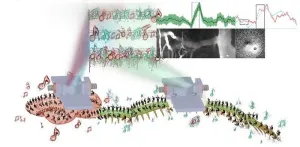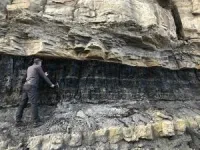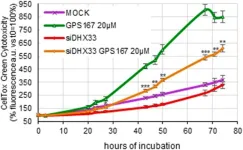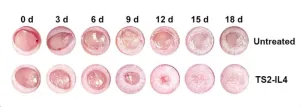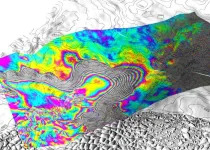(Press-News.org) A sensory process such as pain is no ordinary phenomenon—it’s a symphony of neural and vascular interactions orchestrated by the brain and spinal cord. Attempting to dissect this symphony by focusing on a single region is like trying to understand a complex melody by listening to just one instrument. It’s incomplete, potentially misleading, and may result in erroneous conclusions.
Enter the Carney Institute’s team of visionaries. Their mission? To develop tools that allow unprecedented observation of neural and vascular activity within the brain and spinal cord. They tackled two critical fronts: imaging hardware and bioluminescent (BL) molecular tools.
Innovative imaging hardware
Multi-organ imaging during clinically relevant sensory processes is notoriously challenging. As a result, until now there were no methodological protocols and tools that would offer any guidelines on how to go about imaging multiple sites during clinically relevant sensory behaviors. As reported in Neurophotonics, the team engineered 3D-printed brain and spinal cord implants, revolutionizing surgical implantations and optical access.
Wearable miniscopes coupled with universal implants for advanced microscopy or optogenetic stimulation now provide a backstage pass to the brain and spinal cord.
Bioluminescent imaging
BL imaging overcomes limitations of more traditional fluorescent microscopy. No more photobleaching, phototoxicity, or resolution loss due to scattered excitation signals.
The team conceived the “BLmini,” a modified miniscope optimized for capturing these elusive BL signals.
The Carney Institute’s “universal” implants allow simultaneous acute and chronic imaging of brain–spinal interactions. Imagine watching a live concert from both the orchestra pit and the balcony—now apply that to neural circuits. The BLmini, with its reduced weight, cost, and form-factor, is the star performer, revealing hidden signals like never before.
This coalition of 3D-printed implants, advanced microscopy tools, and bioluminescence techniques holds promise beyond pain research. Neuropathic pain, sensory disorders, and motor behavior are all within its reach. As the spotlight shines on the brain–spinal duet, we’re one step closer to unraveling the symphony of sensory phenomena.
For details, see the original Gold Open Access article by D. Celinskis et al., “Toward a brighter constellation: multiorgan neuroimaging of neural and vascular dynamics in the spinal cord and brain,” Neurophotonics 11(2), 024209 (2024), doi 10.1117/1.NPh.11.2.024209.
END
Illuminating neuro-vascular dynamics throughout the body: 3D-printed implants and bioluminescence duet shed light on brain–spinal interactions
Carney Institute researchers developed a set of novel imaging tools for studying sensory information processing
2024-05-20
ELSE PRESS RELEASES FROM THIS DATE:
Studies show linked biological pathways driving skin inflammation
2024-05-20
A certain biological pathway, a set of linked reactions in the body, drives the inflammation seen in the skin disease psoriasis, a new study finds. The work could lead to improved therapies for all inflammatory skin diseases, including atopic and allergic dermatitis and a type of boil called hidradenitis suppurativa, say the study authors. Inflammation is the body’s natural response to irritation and infection, but when out of control, it can lead to the reddish, flaky, itchy lesions that come with these skin diseases.
Led by researchers at NYU Langone Health, the new study found that the interleukin-17 (IL-17) pathway, ...
Fowler awarded 2023 NASA Planetary Science Early Career Award
2024-05-20
Research Assistant Professor Christopher Fowler received the NASA 2023 Planetary Science Early Career Award for his project “Bringing Planetary Science to West Virginia”. The award is based on demonstrated leadership, involvement in the planetary science community, and potential for future impact.
The resources provided by the NASA Planetary Science Early Career Award will allow Fowler and team to undertake research-related activities that are not always possible within the scope of more “traditional” ...
Anticancer potential of CLK kinase inhibitors 1C8 and GPS167 via EMT and antiviral immune response
2024-05-20
“[...] we have characterized a pair of compounds that impact multiple processes that are relevant to cancer cell proliferation but also, and possibly more importantly, to metastasis [...].”
BUFFALO, NY- May 20, 2024 – A new research paper was published in Oncotarget's Volume 15 on May 16, 2024, entitled, “The anticancer potential of the CLK kinases inhibitors 1C8 and GPS167 revealed by their impact on the epithelial-mesenchymal transition and the antiviral immune response.”
The diheteroarylamide-based compound 1C8 and the aminothiazole carboxamide-related compound GPS167 inhibit the CLK kinases, and affect ...
Aging contributes to 2024 Systems Aging Gordon Research Conference
2024-05-20
Aging is contributing at the 2024 Systems Aging Gordon Research Conference in Barcelona, Spain, from June 2–7.
BUFFALO, NY- May 20, 2024 – Aging is a contributor at the 2024 Systems Aging Gordon Research Conference (GRC) on “Systems Modeling, Aging Biomarkers, and Longevity Interventions” — taking place from June 2–7, 2024, in Castelldefels, Barcelona, Spain.
“The conference will present recent advances in systemic rejuvenation, multi-omics approaches, applications ...
Pioneering research study makes significant contributions toward addressing the shortage of suitable knee meniscus and TMJ disc replacements
2024-05-20
The shortage of suitable donor meniscus grafts from the knee and temporomandibular joint (TMJ) impedes treatments for millions of patients. Vitrification offers a promising solution by transitioning these tissues into a vitreous state at cryogenic temperatures, protecting them from ice crystal damage using high concentrations of cryoprotectant agents (CPAs). However, vitrification's success is hindered for larger tissues (>3 mL) due to challenges in CPA penetration. Dense avascular meniscus tissues require extended CPA exposure for adequate penetration; however, ...
By listening, scientists learn how a protein folds
2024-05-20
CHAMPAIGN, Ill. — By converting their data into sounds, scientists discovered how hydrogen bonds contribute to the lightning-fast gyrations that transform a string of amino acids into a functional, folded protein. Their report, in the Proceedings of the National Academy of Sciences, offers an unprecedented view of the sequence of hydrogen-bonding events that occur when a protein morphs from an unfolded to a folded state.
See video: Protein Sonification
“A protein must fold properly to become an enzyme or signaling molecule or whatever its function may be — all the many things that proteins do in our bodies,” said University of Illinois ...
Nano drug accelerates diabetic wound healing in mice
2024-05-20
New York, NY [May 20, 2024]—Researchers at the Icahn School of Medicine at Mount Sinai have designed a regenerative medicine therapy to speed up diabetic wound repair. Using tiny fat particles loaded with genetic instructions to calm down inflammation, the treatment was shown to target problem-causing cells and reduce swelling and harmful molecules in mouse models of damaged skin.
Details on their findings were published in the May 20 online issue of the Proceedings of the National Academy of Sciences (PNAS).
Diabetic wounds, often resistant to conventional treatments, ...
UC Irvine-led team uncovers ‘vigorous melting’ at Antarctica’s Thwaites Glacier
2024-05-20
Irvine, Calif., May 20, 2024 — A team of glaciologists led by researchers at the University of California, Irvine used high-resolution satellite radar data to find evidence of the intrusion of warm, high-pressure seawater many kilometers beneath the grounded ice of West Antarctica’s Thwaites Glacier.
In a study published today in Proceedings of the National Academy of Sciences, the UC Irvine-led team said that widespread contact between ocean water and the glacier – a process that is replicated throughout Antarctica and in Greenland – causes “vigorous melting” and may require a reassessment of ...
Warm seawater speeding up melting of ‘Doomsday Glacier,’ scientists warn
2024-05-20
EMBARGOED UNTIL 15:00 EDT MONDAY, MAY 20, 2024
For the first time, there is visible evidence showing that warm seawater is pumping underneath Antarctica’s Thwaites Glacier—ominously nicknamed the Doomsday Glacier.
An international team of scientists—including a researcher from the University of Waterloo—observed it using satellite imagery and warns that it could accelerate catastrophic sea level rise in 10 to 20 years.
The intrusion of seawater causes the ice to continuously lift off the land and settle back down again. Ice melts intensely when it first touches seawater, ...
Can coal mines be tapped for rare earth elements?
2024-05-20
Deposits of designated critical minerals needed to transition the world’s energy systems away from fossil fuels may, ironically enough, be co-located with coal deposits that have been mined to produce the fossil fuel most implicated in climate change.
Now, research led by the University of Utah has documented elevated concentrations of a key subset of critical minerals, known as rare earth elements, or REEs, in active mines rimming the Uinta coal belt of Colorado and Utah.
These findings open the possibility that these mines could see a secondary resource stream in the form of metals used in renewable energy and numerous other high-tech ...
LAST 30 PRESS RELEASES:
University of Oklahoma researcher awarded funding to pursue AI-powered material design
Exploring how the visual system recovers following injury
Support for parents with infants at pediatric check-ups leads to better reading and math skills in elementary school
Kids’ behavioral health is a growing share of family health costs
Day & night: Cancer disrupts the brain’s natural rhythm
COVID-19 vaccination significantly reduces risk to pregnant women and baby
The role of vaccination in maternal and perinatal outcomes associated with COVID-19 in pregnancy
Mayo Clinic smartwatch system helps parents shorten and defuse children's severe tantrums early
Behavioral health spending spikes to 40% of all children’s health expenditures, nearly doubling in a decade
Digital cognitive behavioral treatment for generalized anxiety disorder
Expenditures for pediatric behavioral health care over time and estimated family financial burden
Air conditioning in nursing homes and mortality during extreme heat
The Alps to lose a record number of glaciers in the next decade
What makes a good proton conductor?
New science reporting guide published for journalists in Bulgaria
New international study reveals major survival gaps among children with cancer
New science reporting guide published for journalists in Turkey
Scientists develop a smarter mRNA therapy that knows which cells to target
Neuroanatomy-informed brain–machine hybrid intelligence for robust acoustic target detection
Eight SwRI hydrogen projects funded by ENERGYWERX
The Lundquist Institute and its start-up company Vitalex Biosciences Announces Strategic Advancement of Second-Generation fungal Vaccine VXV-01 through Phase 1 Trials under $40 Million Competitive Con
Fine particles in pollution are associated with early signs of autoimmune disease
Review article | Towards a Global Ground-Based Earth Observatory (GGBEO): Leveraging existing systems and networks
Penn and UMich create world’s smallest programmable, autonomous robots
Cleveland researchers launch first major study to address ‘hidden performance killer’ in athletes
To connect across politics, try saying what you oppose
Modulating key interaction prevents virus from entering cells
Project explores barriers to NHS career progression facing international medical graduates
Jeonbuk National University researchers explore the impact of different seasonings on the flavor perception of Doenjang soup
Two Keck Medicine of USC Hospitals named Leapfrog Top Teaching Hospitals
[Press-News.org] Illuminating neuro-vascular dynamics throughout the body: 3D-printed implants and bioluminescence duet shed light on brain–spinal interactionsCarney Institute researchers developed a set of novel imaging tools for studying sensory information processing
